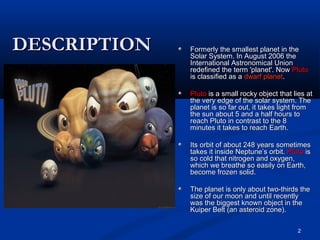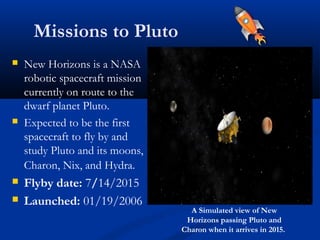Pluto The Dwarf Planet
- 1. PLUTO The Dwarf Planet By: Jonathan Davila Jorge Rodriguez 1
- 2. Pluto Facts Formerly the smallest planet in the Solar System. In August 2006 the International Astronomical Union redefined the term 'planet'. Now Pluto is classified as a dwarf planet. Pluto is a small rocky object that lies at the edge of our solar system. The planet is so far out, it takes light from the sun about 5 and a half hours to reach Pluto in contrast to the 8 minutes it takes to reach Earth. Its orbit of about 248 years sometimes takes it inside Neptune’s orbit. Pluto is so cold that nitrogen and oxygen, which we breathe so easily on Earth, become frozen solid. Pluto is only about two-thirds the size of our moon and recently was the biggest known object in the Kuiper Belt (an asteroid zone). 2
- 3. Location Pluto was the ninth planet in the solar system. The orbit the planet takes around our Sun is an ellipse. There are times when Pluto is the furthest away from the Sun. There are also times when it is closer to the Sun than Neptune. Pluto is a very long way from the Sun. Its average distance from the Sun is over 3.5 billion miles. The closest Pluto gets to the Sun is over 2.7 billion (2,700,000,000) miles, and the furthest away it gets is over 4.5 billion (4,500,000,000) miles. 3
- 4. How Pluto Got It’s Name? Pluto was discovered in 1930 by astronomer Clyde Tom Baugh. Mr. Tom Baugh spent a long time taking photographs of the sky where the unknown planet should be and finally discovered Pluto in one of the photographs. Pluto is the Roman god of darkness and the underworld. Perhaps Pluto got its name because it is in darkness. It may have also gotten its name from the fact that its symbol "PL" are the initials of Percival Lowell, who founded the observatory where Mr. Tom Baugh worked. 4
- 5. Missions to Pluto New Horizons is a NASA robotic spacecraft mission currently on route to the dwarf planet Pluto. Expected to be the first spacecraft to fly by and study Pluto and its moons, Charon, Nix, and Hydra. Flyby date: 7/14/2015 Launched: 01/19/2006 A Simulated view of New Horizons passing Pluto and Charon when it arrives in 2015.
- 6. Mission Objectives Secondary objectives (expected) Primary objectives (required) Characterize the time variability of Characterize the global geology Pluto's surface and atmosphere and morphology of Pluto and Map the terminators (day/night Charon border) of Pluto and Charon with high resolution Map chemical compositions of Pluto and Charon surfaces Map the chemical compositions of select Pluto and Charon areas with Characterize the neutral high resolution atmosphere of Pluto and its Characterize Pluto's ionosphere, escape rate and its interaction with the solar Loss of any of these objectives wind will constitute a failure of the Search for neutral species such as mission. H2, hydrocarbons, HCN and other nitrides in the atmosphere Search for any Charon atmosphere Map surface temperatures of Pluto and Charon
- 7. Size of Pluto Pluto is about 2274 kilometres (1410 miles) in diameter and Charon 1172 kilometres (727 miles) in diameter. 7
- 8. What is Pluto composed of? Pluto was the only planet in our solar system that we have not explored with a spacecraft. The current studies tell us that Pluto is made up of a mixture of rocks and several kinds of "ices". Scientists believe that most of the ices that make up Pluto are frozen methane and ammonia. 8
- 9. The surface of Pluto is very dark and extremely cold. Since the planet is so far away from the Sun, it gets almost no light or Physical Characteristics heat. Scientists believe that the temperature on the Pluto’s surface is over 250 degrees Celsius below zero. At this low temperature, almost everything freezes solid. Scientists here on Earth have determined that Pluto does have a very thin atmosphere, but it is far too thin to support any kind of life. 9
- 10. Pluto’s Moons Pluto has 3 moons Charon Discovered in 1978 Largest of 3 moons Half the size of Pluto No other moon is as large, when compared to its planet. Pluto and Charon are so similar in size that some astronomers think of them as a double planet. Artist’s impression of Charon The other two moons Nix and from Pluto. Hydra are far smaller than Charon. 10
- 11. Pluto and Charon Compared to the US Pluto and Charon 11
- 12. Pluto Facts Radius: 1,137 km Mass: 1.27x1022 kg Shape: round, no rings, 122° tilt Density: 2.05 gm/cm3 Distance from the Sun: 5,913,520,000 km 12
- 13. Scaled Drawing of Orbits 13
- 14. Pluto Size Comparison Earth and Pluto Size Comparison 14
- 16. ¡TIME TO RETURN TO EARTH! Hope You Enjoyed Our Presentation! 16
















